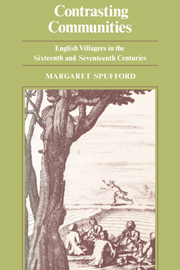Book contents
- Frontmatter
- Contents
- List of maps and graphs
- List of tables
- List of abbreviations
- Acknowledgements
- Dedication
- Introduction
- Map 1 Cambridgeshire: natural boundaries and soil types
- Map 2 Cambridgeshire: county and parish boundaries
- PART 1 People, Families and Land
- 1 The peopling of a county
- 2 The problem: the disappearance of the small landowner
- 3 The reality: the small landholder on the chalk: Chippenham
- 4 The reality: the small landholder on the clay: Orwell
- 5 The reality: the small landholder in the fens: Willingham
- General Conclusions to Part One
- PART 2 The Schooling of the Peasantry
- PART 3 Parishioners and their Religion
- Conclusion
- Appendix 1 The Butlers of Orwell
- Appendix 2 Notes on Graphs 3 and 5
- Index of Contemporary Names
- General Index
3 - The reality: the small landholder on the chalk: Chippenham
Published online by Cambridge University Press: 25 January 2010
- Frontmatter
- Contents
- List of maps and graphs
- List of tables
- List of abbreviations
- Acknowledgements
- Dedication
- Introduction
- Map 1 Cambridgeshire: natural boundaries and soil types
- Map 2 Cambridgeshire: county and parish boundaries
- PART 1 People, Families and Land
- 1 The peopling of a county
- 2 The problem: the disappearance of the small landowner
- 3 The reality: the small landholder on the chalk: Chippenham
- 4 The reality: the small landholder on the clay: Orwell
- 5 The reality: the small landholder in the fens: Willingham
- General Conclusions to Part One
- PART 2 The Schooling of the Peasantry
- PART 3 Parishioners and their Religion
- Conclusion
- Appendix 1 The Butlers of Orwell
- Appendix 2 Notes on Graphs 3 and 5
- Index of Contemporary Names
- General Index
Summary
Sources, population changes, fields, crops and stock
The parish of Chippenham lies right out in the north-east of Cambridgeshire, near Newmarket and the Suffolk border. Its hamlet of Badlingham, which formed a separate manor, bordered on the river Kennet, across which Neolithic man had found his most hospitable environment on the sandy soils of the Breckland. Chippenham comes close to a local historian's paradise though even there the documentation is incomplete. The manor was monastic, and had served as the Infirmary of the Hospitallers in England. The village itself lay immediately south of an inlet of the fen. The High Street stretched from the parish church, down to the village green, where South Street crossed the High Street. On the way, it passed the manor house and infirmary buildings with their chapel, where convalescent brethren had once strolled in the three courtyards and the great garden within the moat, before returning to the heat of Rhodes.
The manor of Chippenham was one of the pieces of property in Cambridgeshire acquired by Sir Edward North from the court of Augmentations. Sir Edward had it surveyed in October 1544, and the document which was the result of this survey ran to seventy-nine folios. It listed every one of the sixty-three messuages and cottages which still stood there, every croft or enclosure where there had ever been a messuage or cottage, every single strip in the open fields and its abutments, and the commons and common rights.
- Type
- Chapter
- Information
- Contrasting CommunitiesEnglish Villages in the Sixteenth and Seventeenth Centuries, pp. 58 - 93Publisher: Cambridge University PressPrint publication year: 1974



